Who’s hungry to taste a rainbow? Of course, that rainbow happens to be made of bugs. And you happen to be a chameleon. And you are trying to avoid snakes. But that’s what life is like when you are a lizard.
What Is Life of a Chameleon?
Life of a Chameleon is a set collection game where you play as a chameleon who can change their color to collect bugs, complete objectives, and score points. The game is for two to four players, ages twelve and up. The box says it takes 45 to 60 minutes to play, and I found that pretty accurate. It is a quick learn and easy to play, but the depth it presents can be very deceptive at first. The list price for the game is $46.99. You can purchase it from the Last Night Games online store, and you can find it on Amazon.
Life of a Chameleon was designed by two brothers, Nathan and Jake Jenne, and published by their company, Last Night Games, with illustrations by Jake Jenne. Last Night Games is a small publisher with several fun-looking games on the horizon.
Life of a Chameleon Components
When I opened the box for Life of a Chameleon, the first thing I noticed was the organization! And while it may not be an official component of the game, I’d like to point out that the inclusion of a box insert that holds and organizes the game components is a very welcome addition! Anything that keeps my game organized despite moving it around a lot rates high in my book.
The actual components of the game are:
- 1 game board
- 1 progress board
- 21 uniquely colored wooden chameleon tokens
- 6 uniquely colored wooden snake tokens
- 90 wooden insect cubes (15 in each of six colors)
- 1 progress indicator disc
- 1 six-sided “bug-colored” die
- 1 20-sided die
- 1 four-sided die
- 21 color cards
- 29 achievement cards
- 30 objective cards
- 1 instruction manual
The first thing you notice after the amazing organizational insert is how bright and colorful this game is. The colors play a very important role throughout as you will see. As mentioned, the box and components are well thought out and designed. There are even two self-locking bags for you to put the bugs and chameleon tokens in to help keep things tidy.
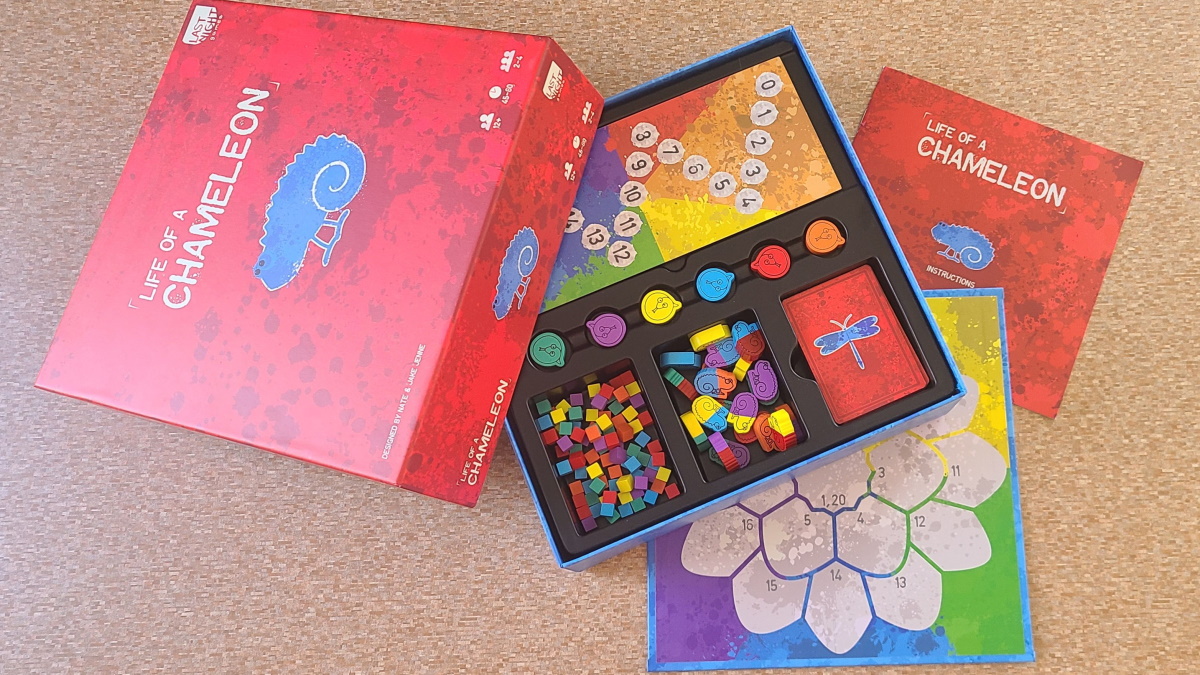
The chameleon tokens are made from wood and painted in 21 different color combinations, some solid, and others a mix of two colors on one chameleon. You play as a chameleon, but not just one chameleon. You will swap your token throughout the game as you change colors to help you get new bugs and complete different objectives.

The snake tokens are every bit as fun as the chameleons. There are six different colors, and like the chameleons, the art, paint, and general workmanship are very good. I like the fact that the tokens aren’t simple shapes, but rather mimic what they represent, bringing an extra layer of whimsy to the game. I didn’t notice any chips or bad paint spots on any of the tokens, which really impressed me.

The bugs are colored cubes. There are 90 of them in the game—15 in each of the six different colors. While it might be hard to get very excited about cubes, the fact they are wooden and the overall quality keeps right up there with the rest of the components.
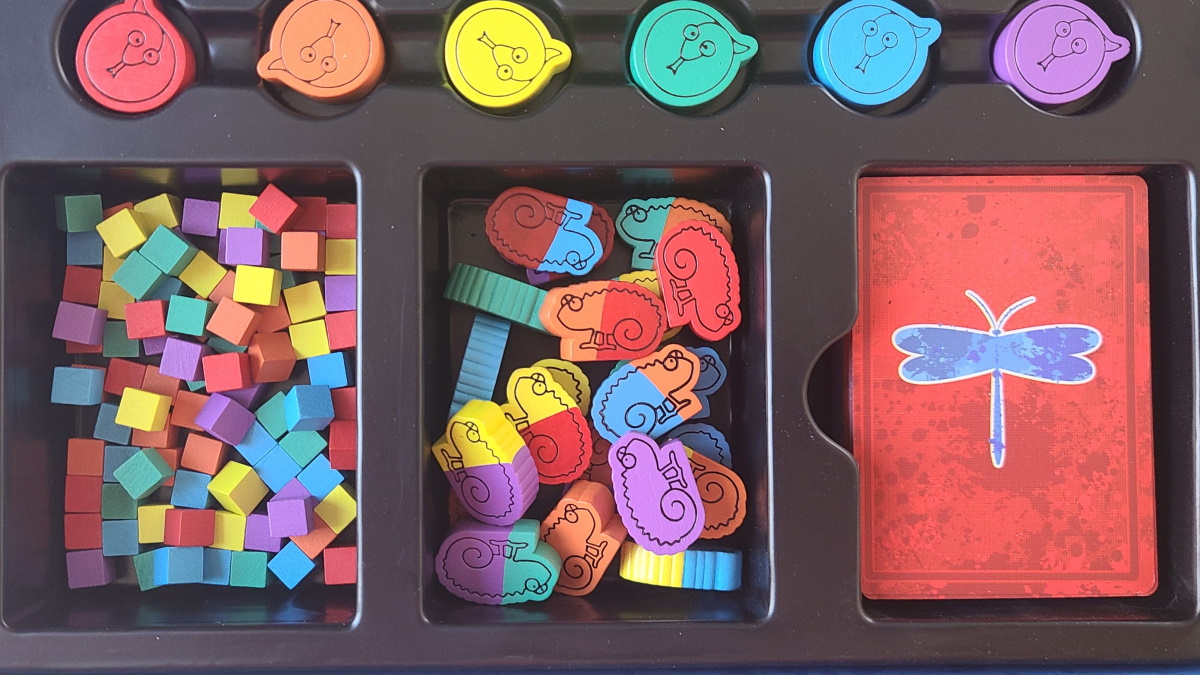
There are three different types of cards in Life of a Chameleon. There are 21 color cards that correspond to the colors of the chameleons. These are used by the player to choose which chameleon token they will use. They have a purple back with an image of a chameleon on them. The achievement cards have a blue back with a star and represent different awards you receive surrounding objectives. Finally, the objective cards have a red back with a dragonfly image on them. These cards show the different objectives you are trying to complete throughout the game.

The card quality is just as impressive as the rest of the game. The cards feel like they are printed on fairly heavy stock, and the embossed finish on them makes them very nice to work with, without being too slippery. I really wish more game manufacturers would look at these cards when it comes time to print theirs!
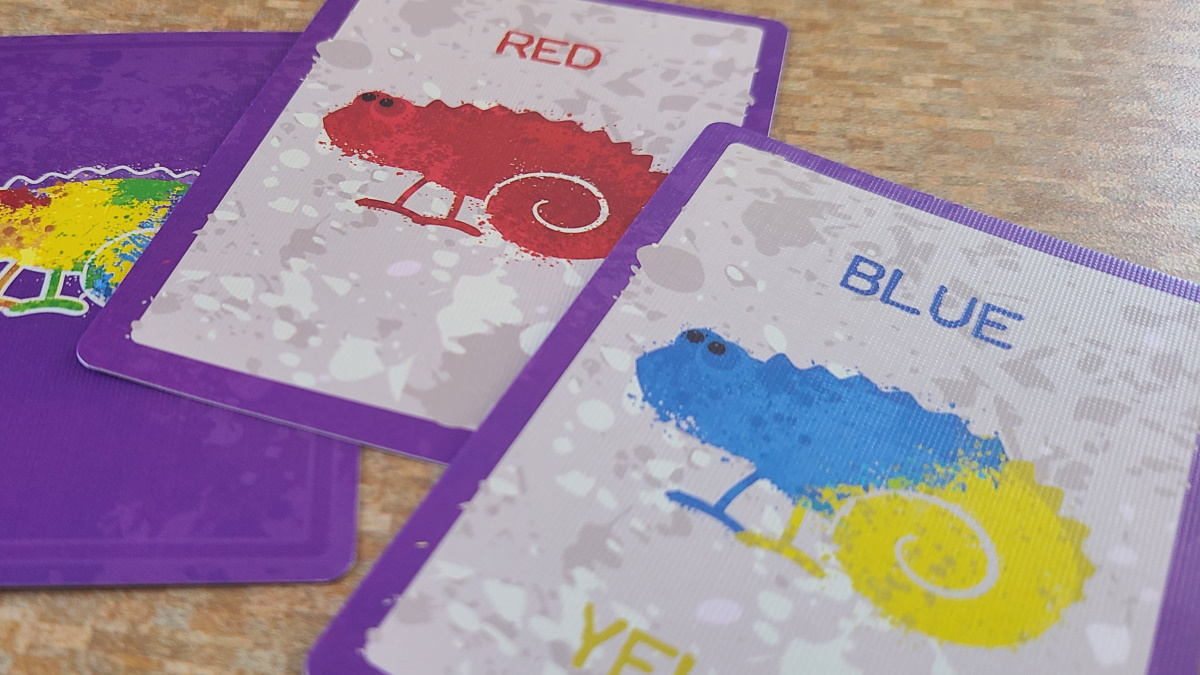
The dice are interesting in this game, with the 20-sided and 4-sided dice being standard, white plastic dice. The 6-sided color die is wooden, and each face has an image on it in one of the six colors found throughout the game. It feels like a minor bump in the road of consistency that we’ve had in this game so far, and in fact, the back of the box I have does show a white plastic 6-sided die with a circle of color on each face. Overall, the wooden color die quality is still good, and it does tie into the theme of the game very well, so this is probably just me trying to nitpick.

The game board and progress board are well designed and colorful, just as you would expect at this point. It is interesting that rather than going for a solid color on the back of the boards, Last Night Games instead opted to repeat the board design, but monochromatic instead. The color on the boards doesn’t add anything directly to the game itself, so you can choose which side you want to use. The board is not very big, and mine was slightly warped, making it much easier to play on one side versus the other.
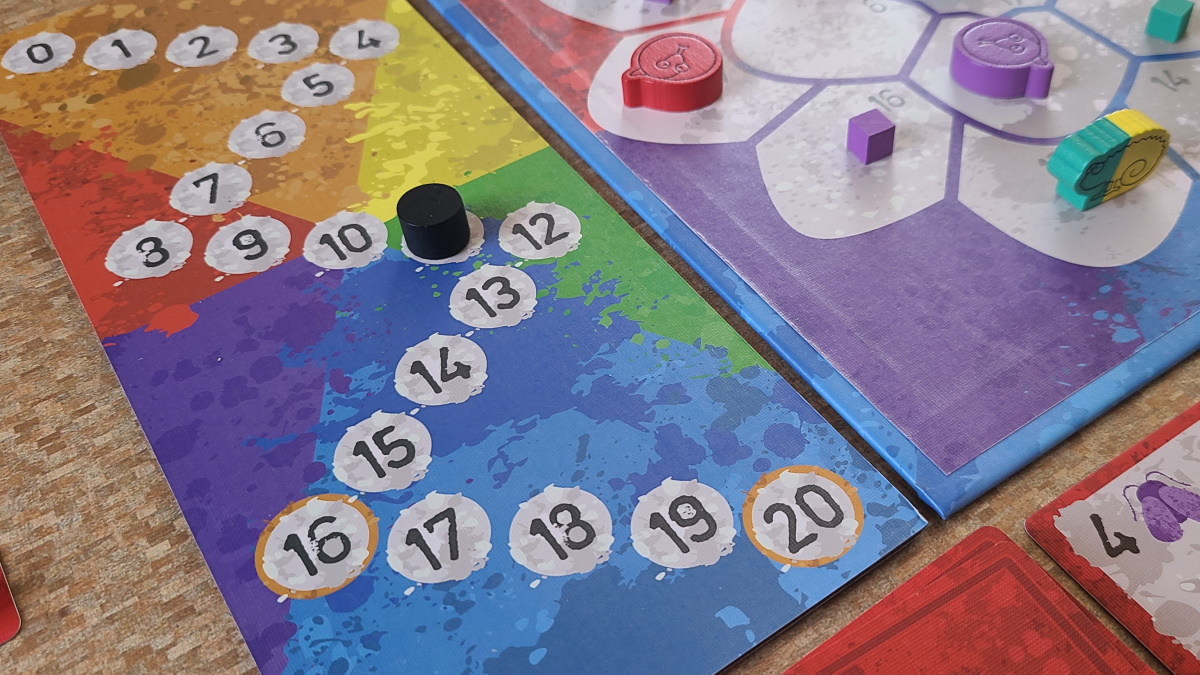
The instructions deserve special mention, because not only are they printed on quality paper, but they are also very descriptive and helpful. One of the challenges in teaching any game is how to cover concepts that don’t quite apply yet, but you need to mention them in order to convey the current concept. Last Night Games has done a very good job with the Life of a Chameleon instructions, and I found them very easy to follow.
How do You Play Life of a Chameleon
What Is My Chameleon Trying to Do
Life of a Chameleon is a game in which you are trying to eat bugs, complete objectives, and score the most points before the progress marker signals the end of the game. It isn’t a simple free-for-all eating the bugs though, as your path is often blocked by snakes, and your meal often runs away because you don’t blend in well enough. So, you need to adapt, change colors, avoid the snakes, and sneak up and eat those bugs.
Setting Up the Game
Setting up Life of a Chameleon is very simple and goes quickly once you have done it once or twice. It is a random setup, drawing and placing snakes and bugs to get the starting tableau ready. The snakes are placed in a ring on the board, and one bug cube is placed in each space except the center space, which is where the chameleons start. You shuffle the three decks of cards, and then deal one color card to each player, giving them their starting chameleon color. Each player takes that chameleon and places it in the center space on the board, marked 1,20. The remaining color cards are placed at the top of the board within easy reach, and three are then turned face up along the top of the board, creating your choices for changing colors on your turn.
The achievement cards are placed face down within easy reach of all players. Finally, four objective cards are dealt along the bottom of the board, with the remaining cards placed face down next to them. These form your options for choosing objectives on your turn when it is allowed to take them.
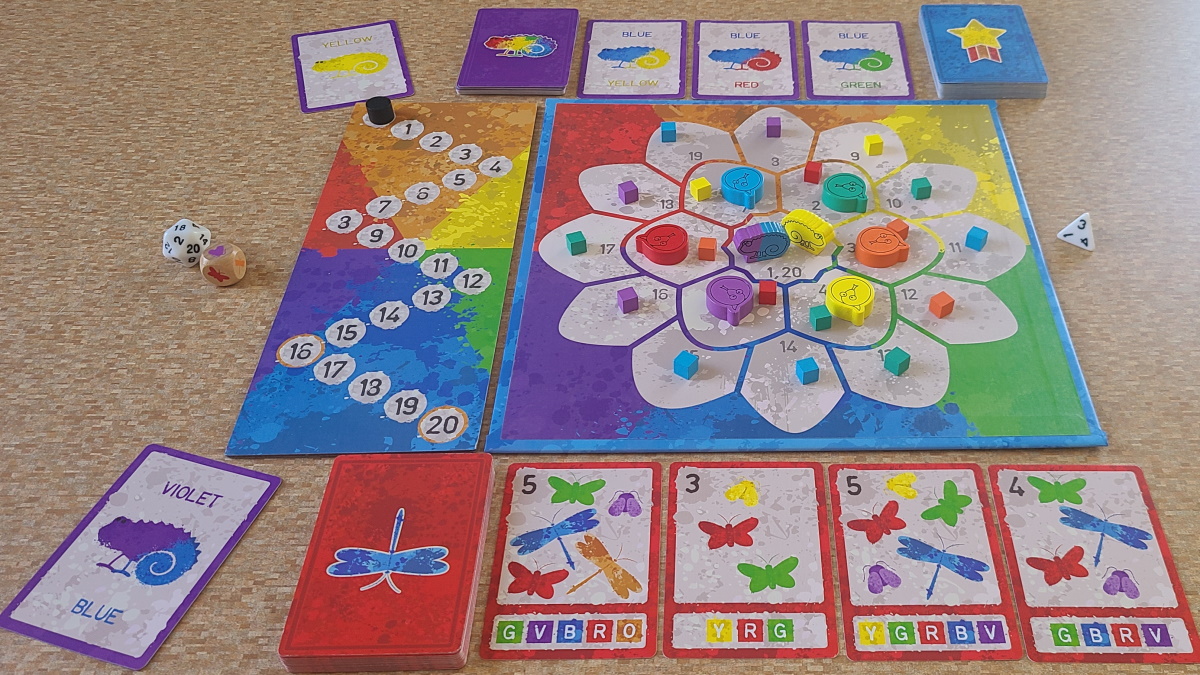
The remaining chameleons and bugs are set to the side forming stockpiles. You will swap your current chameleon for one of a new color when you take that action so you can continue your moves along the board, and your current chameleon goes back in the stock. The bugs will be used to replenish the board at certain times, and it should be noted that it is possible to run out of bugs during the game. This adds some complexity to choices in games with three and four players.
Once all of this is done, you need to determine the first player. While the instructions offer no advice on how to pick, it seems natural that whoever last visited the reptile house at their local zoo should be the first player. If that doesn’t work for you, then I will leave you to your own devices for choosing the starting player in your game.
Striking Out Into the Jungle
You begin your turn by rolling the 20-sided die and the six-sided die. You then place a bug cube of the color shown on the six-sided die on the board space indicated by the 20-sided die. In this manner, there is at least one new bug per player turn. At that point, you can then take up to three actions on your turn. You can move your chameleon, move a snake, change your chameleon’s color, or lie in wait for more bugs.
You can move your chameleon token to any adjacent space on the board, including spaces with other chameleons. The only restriction is that you cannot move into a space with a snake unless that snake shares your color. If you are a bi-colored chameleon at the moment, at least one of your colors must match a snake to share a space with it. When you move into a new space, you then check the bugs that are in that space. If any of them do NOT share a color with you, they scatter to adjacent spaces. This way, only bugs that share a color with you will remain, giving you the opportunity to eat them and work toward your objectives.
When bugs move, you get to choose where to move them. You move them to any adjacent space, and if that space has a chameleon the same color as the bug, you move the bug again. In this manner, you can chain bug moves together to help you achieve your objectives or keep your opponents from achieving theirs!
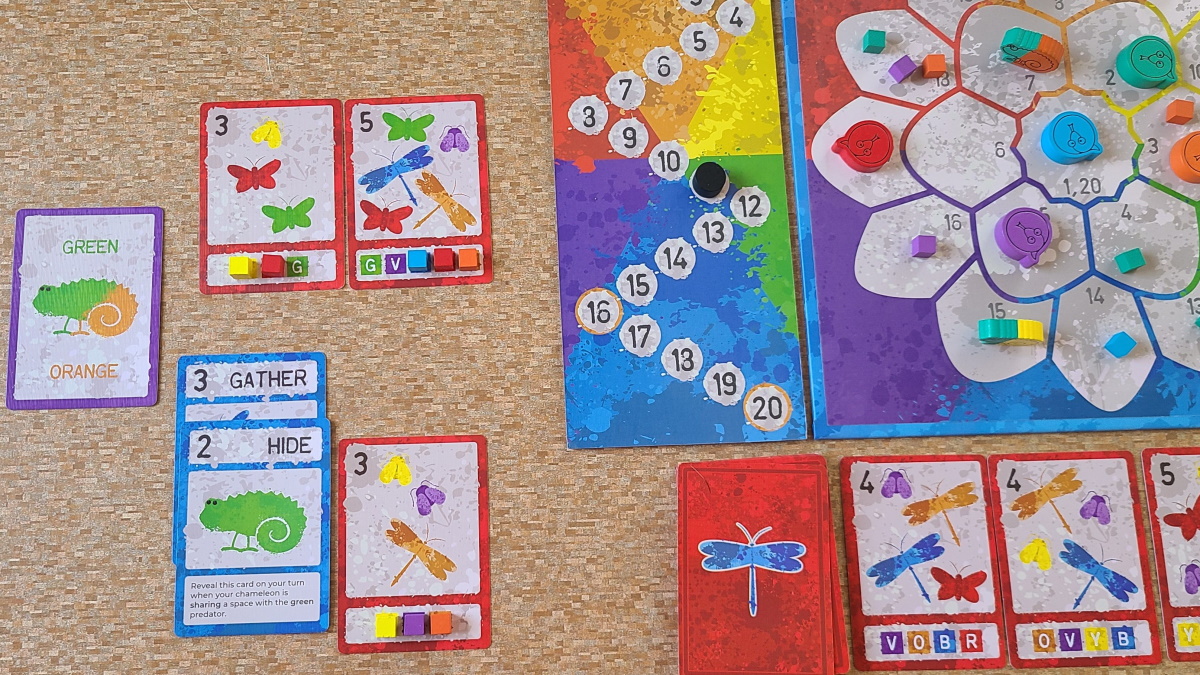
If you decide to move a snake for one of your actions, you can move any snake to any space adjacent to it. There can only be one snake per space, so if that space already has a snake in it, you continue to move the snake until it reaches a space with no other snakes. All of this only counts as a single action. Also, you cannot move a snake into a space with a chameleon unless they share a color. Snakes and bugs don’t pay much attention to each other, so just ignore the bugs when it comes to moving snakes.
Another action you can take is changing your chameleon’s color. You will find throughout the game that the bug you need is a different color than you are or is blocked by a snake of a different color, or just that you really want to be green right now. Whatever the reason, for one of your actions, you can change your color by taking one of the face-up color cards above the board. If none of those suit your desires, you can take your chances by drawing the top color card from the face-down deck. If you do draw the top card from the deck, you are not required to change to its color if you don’t want to, but it still costs your action. Also, you can never change your chameleon to a color that would violate the rule about snakes and chameleons sharing spaces if they don’t share a color. Once you have your new color, discard your old color card, then find the matching chameleon token and swap it on the board with your old token. In Life of a Chameleon, it is recommended to always keep your current color card in front of you to help you remember which token is actually yours, and I heartily agree with this after playing a few games and losing track of which color I was a few times! If you do take a face-up color card, you don’t replenish it until the end of your turn. If the color card deck runs out, shuffle the discarded color cards to form a new deck.
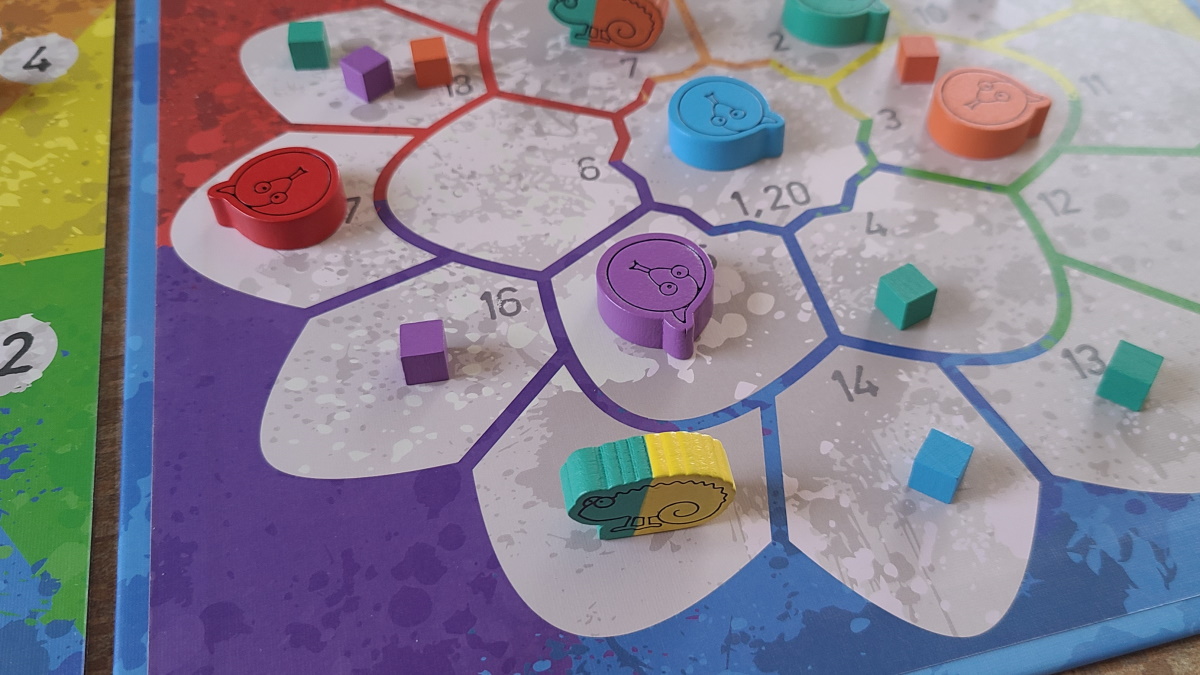
The final action you can take is to lie in wait for more bugs. Doing this means you will roll the 20-sided die up to three times, placing a bug in a color of your choice on the space indicated. Yes, that does mean that one action of placing new bugs allows you to place up to three new bugs. All the rules of moving bugs apply here as well. You can’t place bugs on spaces with chameleons of a different color. If for some reason you do, that bug is immediately scared into an adjacent space.
So you are moving around the board, avoiding snakes, and changing your color. Why? Well, to eat bugs, of course! When you share a space with a bug the same color as you, you can eat that bug. When you eat a bug, you either stash it in front of you for later, or you use it to work on an objective. Stashing bugs allows you to keep up to five bugs in front of you that are not on an objective card. Objective cards are worth points by filling them up with the bugs indicated on the bottom of the card. You must fill the card in order from left to right or right to left. To take a card in the first place, you would eat a bug matching the first spot on the left or right of an available card. You could then take that card, place it in front of you, and place the bug you just ate on it. Once you have chosen the direction you are filling a card, you must continue in that direction.
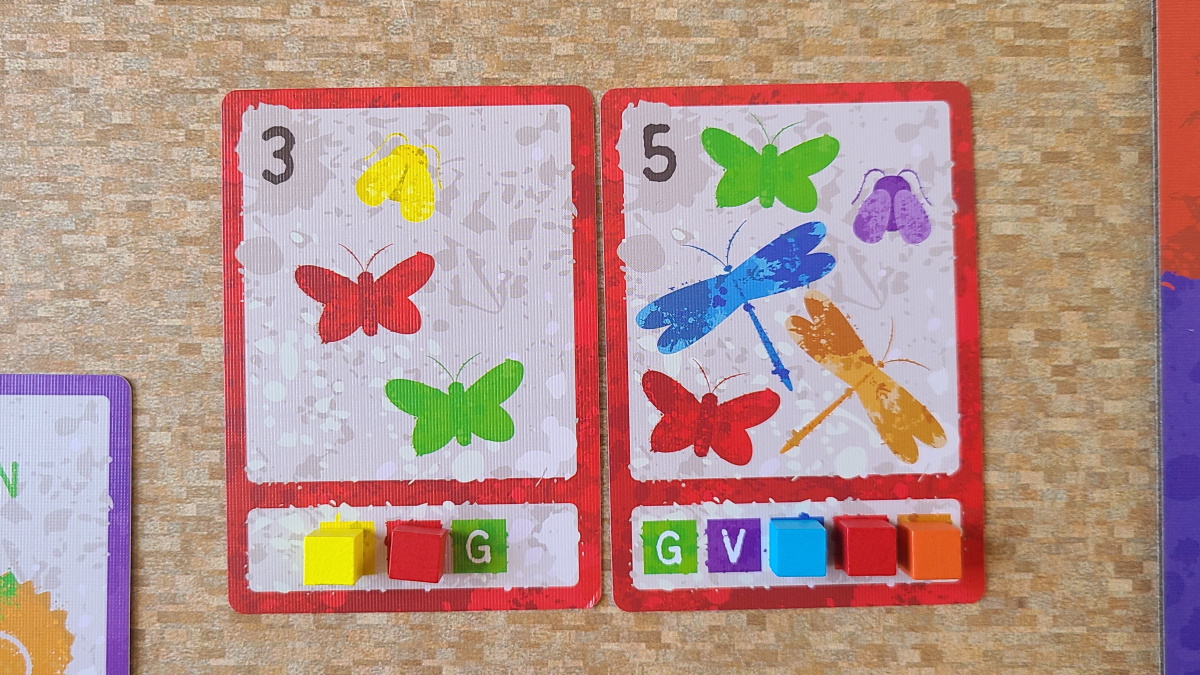
When you complete an objective card, it stays in front of you, with the bugs on it, for scoring later in the game. By the way, any objective cards that are not finished at the end of the game count against you, so think carefully before you eat that tasty bug just to take a new card! Whenever you start or complete an objective card, you take an achievement card. Achievement cards come in goal and event types.
The goal cards include a gather card that tasks you with collecting three bug colors together on a board space. If you are ever adjacent to a space with bugs of those three colors, you complete this goal and can set it aside to collect its points at the end of the game. The other goal is a hide card, which gives you points for sharing a space with the snake of the color indicated. When you find yourself sharing a space with a snake of the color indicated, reveal the card and set it aside for end-of-game scoring.

The event cards include sneak, allowing you to occupy a space with a snake of a non-matching color. You play this card when entering the space with the non-matching snake, and can keep using the card as long as you occupy that space. Once you or the snake moves on, you must discard the sneak card. The move bug event card allows you to move any bug to any space adjacent to it. You must obey the bug movement rules, but this can be a great way to get a bug away from a snake so you can eat it! The final event card allows you to take an extra action during your turn. There is also a wild card that you can use, even during end-of-game scoring, to take a bug of any color from the supply and put it in your stash or directly on an objective card.
Your turn ends when you have taken three actions. Replenish any color cards and objective cards that were taken during your turn. Then pass the 20-sided and six-sided dice to the next player and continue in the same manner.
I’m Full, Now What
Each time a player completes an objective, they roll the four-sided die and advance the progress marker on the progress board that number of spaces. In this manner, as objectives are completed, the end of the game looms nearer, and the pressure is on to complete any objective cards you might have. The game ends when the progress marker reaches 16 for a two-player game, or when it reaches 20 for a three or four-player game. The active player completes their turn before anyone adds up their scores.
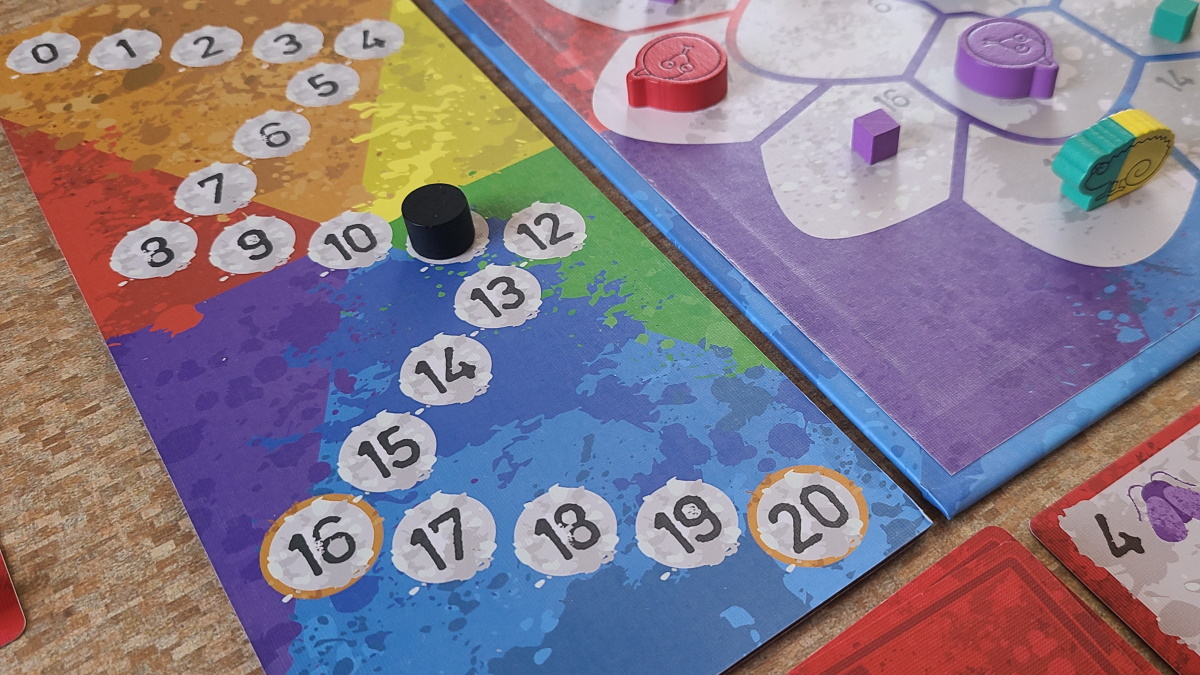
When it is time to calculate your score, you are allowed to place any bugs in your stash on any of your objective cards, following the placement rules of course. You may also trade any two bugs of the same color in your stash for a single bug of another color in the supply at this point. Finally, if you have any wild cards, this is the time to play them and collect the bugs you need. If the supply of bugs runs out during this phase, the active player completes their bug exchanges first, then the next players in order go until everyone is done or the bug supply is exhausted. You cannot start any new objective cards at this time.
Once everyone has placed their final bugs, all players add up their points from completed objectives and achievement cards. If you have any unfinished objectives, you lose two points for each one. The winning player is the one with the highest score, and the victory is shared in the event of a tie.
Why You Should Play Life of a Chameleon
Life of a Chameleon is a joy to look at and fun to play. At first glance, it might seem really simple, and it is very easy to learn and teach to others. But after playing a few rounds, you see the trade-offs you need to make when you choose one path versus another path. Now I’m not saying this game is a heavy strategic thinker, but it also isn’t a throwaway dice-rolling luck game. It sits in a nice zone of accessibility and easy depth that offers a great game for players who might not otherwise want to play games. But it also offers enough for more serious players to sit down and play a game or two as well.
One thing that is often talked about is replay value. Perhaps I look at replay value a bit differently, but Life of a Chameleon has a lot of that for me. A lot of different people sit down at my table to play games, with a lot of different gaming experiences. When I find them staring at me blankly as I explain how to play a massive 4X space game, I can just take a slow breath, put that game away, grab Life of a Chameleon, and I know they’ll have fun. While it might be similar each time I play it, there is enough variation for me to keep it enjoyable.
I enjoyed Life of a Chameleon and have already found it on my table several times since receiving it. The playtime can range from 30 minutes up to an hour, and the player interaction stays pretty high as the turns go quickly. I would highly recommend this game to people looking for a less involved game that is fun to play and engaging at the same time.
Click here to see all our tabletop game reviews.
![]() To subscribe to GeekDad’s tabletop gaming coverage, please copy this link and add it to your RSS reader.
To subscribe to GeekDad’s tabletop gaming coverage, please copy this link and add it to your RSS reader.
Disclosure: GeekDad received a copy of this game for review purposes. As an Amazon affiliate, I may earn a small commission on qualified purchases.





